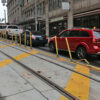Note: This article was originally published on Sunday, April 23, 2023 at 8:03 in the evening and has been updated.
The Do Not Disturb sign has been an ubiquitous part of the lodging landscape since the beginning of the twentieth century as a simple yet tangible solution to the weary traveler who wanted to sleep — or, perhaps, do other things in the privacy of his or her room that should not be publicly known — but are Do Not Disturb signs becoming obsolete?
Are Do Not Disturb Signs Becoming Obsolete?
Several factors may be contributing to the possible demise of the Do Not Disturb sign — one of which has become increasingly common as a result of the 2019 Novel Coronavirus pandemic: housekeeping service of rooms is no longer automatically offered or expected on a daily basis.

As an example, complimentary housekeeping is only offered upon request in many Hampton Inn and Suites hotel properties, with a full cleaning of the room every fifth day for stays of a minimum of four nights — meaning that members of the housekeeping staff have no reason to enter a hotel room during the stay of up to three consecutive nights of any guest. Do Not Disturb signs are no longer available in many of these hotel rooms as a result.
The Advancement of Technology
Another reason is that some hotel rooms are equipped with a mechanism — whether electronic or mechanical — that replaces the placard with Do Not Disturb printed on it.

One example of this is in the form of a button inside of the room which activates an indicator outside of the room that alerts members of the housekeeping staff not to enter the room — at least, not without permission from the guest inside of the room.
Discouraging Illegal Activities in Hotel Rooms
Also attributed to instigating this change in policy is the mass shooting by Stephen Paddock, who launched rampant consecutive rounds of gunfire from his room on the 32nd floor of the Mandalay Bay Las Vegas hotel property just after 10:05 in the evening on the night of Sunday, October 1, 2017. A Do Not Disturb sign hung for several days from the door of the hotel room in which Paddock occupied, which purportedly enabled him to conceal the ammunition which he smuggled into the hotel property.

Some guests have used the Do Not Disturb placard as a way to temporarily convert their hotel rooms into laboratories to manufacture methamphetamine — as well as conduct prostitution, participate in trafficking human beings, and condone other forms of suspicious and illicit activities. Whether the removal of the Do Not Disturb sign actually mitigated illegal and unlawful activities is unknown.
Since the attack — in order to supposedly prevent future hotel rooms from becoming arsenals of weapons and preventing another inexplicable mass killing from happening — some lodging companies and independent hotel and resort properties adopted policies to implement what are known as room checks. This generally means that a member of the housekeeping staff or security staff can enter a hotel room every 12 hours to every 48 hours without permission by the guest — whether or not he or she is occupying the room; and despite any indication by the guest not to disturb the room.
People Collect Do Not Disturb Signs
People collect Do Not Disturb signs by taking them from the rooms of hotel and resort properties. Edoardo Flores alone claims to have greater than 15,000 different types of Do Not Disturb signs from hotel and resort properties around the world over the years — some of them are spartan and basic; while others are creative and unique — and family members, friends, and colleagues have helped to contribute to his vast collection.

As minor as the expense may be in the purchase of Do Not Disturb signs for hotel and resort properties, perhaps saving money might yet be another reason contributing to their disappearance?
Final Boarding Call
Although the basic Do Not Disturb sign may not completely disappear altogether from hotel and resort properties anytime soon, the aforementioned reasons are contributing to their unavoidable demise.
When was the last time you saw a Do Not Disturb sign in a hotel or resort property?
All photographs ©2017, 2018, 2019, ©2022, and ©2023 by Brian Cohen.

